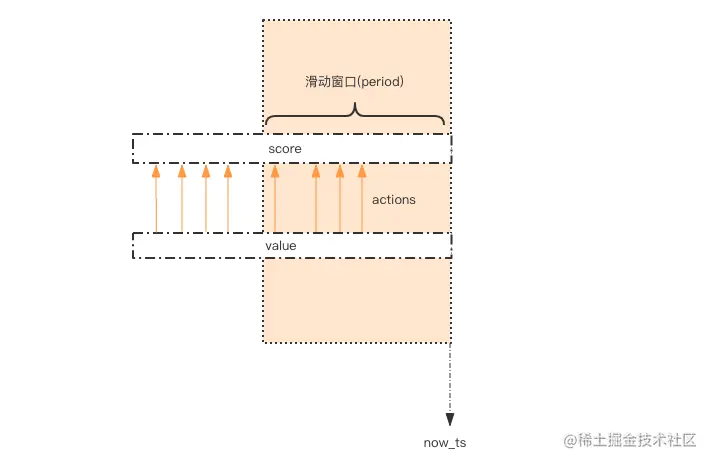应用 6:断尾求生 —— 简单限流
限流算法在分布式领域是一个经常被提起的话题,当系统的处理能力有限时,如何阻止计划外的请求继续对系统施压,这是一个需要重视的问题。老钱在这里用 “断尾求生” 形容限流背后的思想,当然还有很多成语也表达了类似的意思,如弃卒保车、壮士断腕等等。
除了控制流量,限流还有一个应用目的是用于控制用户行为,避免垃圾请求。比如在 UGC 社区,用户的发帖、回复、点赞等行为都要严格受控,一般要严格限定某行为在规定时间内允许的次数,超过了次数那就是非法行为。对非法行为,业务必须规定适当的惩处策略。
如何使用 Redis 来实现简单限流策略?
首先我们来看一个常见 的简单的限流策略。系统要限定用户的某个行为在指定的时间里只能允许发生 N 次,如何使用 Redis 的数据结构来实现这个限流的功能?
我们先定义这个接口,理解了这个接口的定义,读者就应该能明白我们期望达到的功能。
# 指定用户 user_id 的某个行为 action_key 在特定的时间内 period 只允许发生一定的次数 max_countdef is_action_allowed(user_id, action_key, period, max_count):return True# 调用这个接口 , 一分钟内只允许最多回复 5 个帖子can_reply = is_action_allowed("laoqian", "reply", 60, 5)if can_reply:do_reply()else:raise ActionThresholdOverflow()
先不要继续往后看,想想如果让你来实现,你该怎么做?
解决方案
这个限流需求中存在一个滑动时间窗口,想想 zset 数据结构的 score 值,是不是可以通过 score 来圈出这个时间窗口来。而且我们只需要保留这个时间窗口,窗口之外的数据都可以砍掉。那这个 zset 的 value 填什么比较合适呢?它只需要保证唯一性即可,用 uuid 会比较浪费空间,那就改用毫秒时间戳吧。

如图所示,用一个 zset 结构记录用户的行为历史,每一个行为都会作为 zset 中的一个 key 保存下来。同一个用户同一种行为用一个 zset 记录。
为节省内存,我们只需要保留时间窗口内的行为记录,同时如果用户是冷用户,滑动时间窗口内的行为是空记录,那么这个 zset 就可以从内存中移除,不再占用空间。
通过统计滑动窗口内的行为数量与阈值 max_count 进行比较就可以得出当前的行为是否允许。用代码表示如下:
# coding: utf8import timeimport redisclient = redis.StrictRedis()def is_action_allowed(user_id, action_key, period, max_count):key = 'hist:%s:%s' % (user_id, action_key)now_ts = int(time.time() * 1000) # 毫秒时间戳with client.pipeline() as pipe: # client 是 StrictRedis 实例# 记录行为pipe.zadd(key, now_ts, now_ts) # value 和 score 都使用毫秒时间戳# 移除时间窗口之前的行为记录,剩下的都是时间窗口内的pipe.zremrangebyscore(key, 0, now_ts - period * 1000)# 获取窗口内的行为数量pipe.zcard(key)# 设置 zset 过期时间,避免冷用户持续占用内存# 过期时间应该等于时间窗口的长度,再多宽限 1spipe.expire(key, period + 1)# 批量执行_, _, current_count, _ = pipe.execute()# 比较数量是否超标return current_count <= max_countfor i in range(20):print is_action_allowed("laoqian", "reply", 60, 5)
Java 版:
public class SimpleRateLimiter {private Jedis jedis;public SimpleRateLimiter(Jedis jedis) {this.jedis = jedis;}public boolean isActionAllowed(String userId, String actionKey, int period, int maxCount) {String key = String.format("hist:%s:%s", userId, actionKey);long nowTs = System.currentTimeMillis();Pipeline pipe = jedis.pipelined();pipe.multi();pipe.zadd(key, nowTs, "" + nowTs);pipe.zremrangeByScore(key, 0, nowTs - period * 1000);Response<Long> count = pipe.zcard(key);pipe.expire(key, period + 1);pipe.exec();pipe.close();return count.get() <= maxCount;}public static void main(String[] args) {Jedis jedis = new Jedis();SimpleRateLimiter limiter = new SimpleRateLimiter(jedis);for(int i=0;i<20;i++) {System.out.println(limiter.isActionAllowed("laoqian", "reply", 60, 5));}}}
这段代码还是略显复杂,需要读者花一定的时间好好啃。它的整体思路就是:每一个行为到来时,都维护一次时间窗口。将时间窗口外的记录全部清理掉,只保留窗口内的记录。zset 集合中只有 score 值非常重要,value 值没有特别的意义,只需要保证它是唯一的就可以了。
因为这几个连续的 Redis 操作都是针对同一个 key 的,使用 pipeline 可以显著提升 Redis 存取效率。但这种方案也有缺点,因为它要记录时间窗口内所有的行为记录,如果这个量很大,比如限定 60s 内操作不得超过 100w 次这样的参数,它是不适合做这样的限流的,因为会消耗大量的存储空间。
小结
本节介绍的是限流策略的简单应用,它仍然有较大的提升空间,适用的场景也有限。为了解决简单限流的缺点,下一节我们将引入高级限流算法——漏斗限流。
